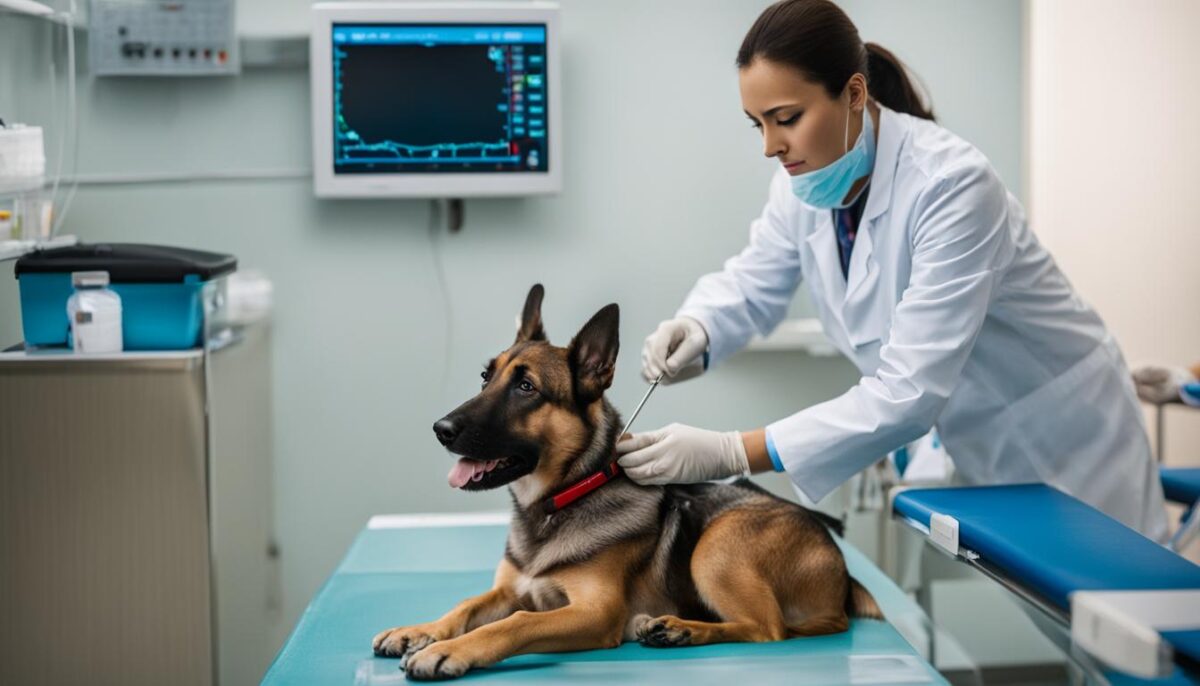Welcome to our article on whether dogs can eat cold food. If you’ve ever wondered if it’s safe to feed your furry friend chilly meals, we have the answers for you. We’ll explore dogs’ temperature preferences. We’ll also provide insights into feeding them cold food.
Feeding dogs cold food is a common practice among pet owners. Many pet food companies recommend serving food at room temperature. This enhances its taste and smell. But, some owners choose to warm chilled food before offering it to their pets. The decision to warm or serve food cold depends on various factors. These include your dog’s preferences and specific health conditions.
Anxious all day cuz my dog won’t eat. Made him boiled chicken and rice with baby food chicken gravy and no dice. 😥
— Thyst 🐞 (@Thyst03) November 7, 2020
Desperately offer him a plate of cold peas and he chows down 😐. pic.twitter.com/5ygm7YAnIb
The Importance of Balanced Temperature in Pet Nutrition
In traditional Chinese medicine (TCM), practitioners classify food as cooling, warming, or neutral. Based on their perceived impact on the body’s energy balance, they classify this. Researchers believe that feeding energy-based foods may restore balance. It can also address specific health conditions in pets. Cooling foods may help reduce symptoms of excessive heat. These symptoms include inflammation or restlessness. Examples of cooling foods for pets include certain types of fish, rabbit meat, and duck. Warming foods, can help balance cold conditions or deficiencies. Warming foods may include beef, chicken, lamb, and salmon. We should use TCM principles as a complementary approach. Consulting with a veterinarian is essential for proper pet nutrition.
Also to TCM principles, the temperature of the food itself can have an impact on pet nutrition. Dogs can eat cold food. It’s important to consider their individual preferences and specific health conditions. Some dogs may prefer warmer food as it enhances the taste and aroma, making it more enticing to eat. This can be especially beneficial for convalescing dogs. It can also help elderly dogs with a diminished sense of smell, or finicky eaters. Warming the food can help make it more appealing and easier to digest.
But, it’s important to strike a balance between temperature preferences and nutritional needs. Cold food can be safe for dogs to eat. But, the diet must still offer essential nutrients for their health. This ensures their well-being. Consulting with a veterinarian is crucial. It ensures that you balance your dog’s diet and meet their specific requirements. They can provide guidance on the appropriate types and amounts of food to feed your dog. They consider their age, breed, and activity level. They also consider any existing health conditions.
Understanding the importance of balanced temperature in pet nutrition helps. It enables you to make informed decisions. This will help you choose what to feed your dog. In the end, this understanding is important. Whether you choose to serve cold or warm food, focus on their nutritional needs. Consider their preferences and health conditions. This is key to keeping them happy and healthy.
Table: Examples of Cooling and Warming Foods in Traditional Chinese Medicine (TCM)
| Cooling Foods | Warming Foods |
|---|---|
| Types of fish | Beef |
| Rabbit meat | Chicken |
| Duck | Lamb |
Measuring and Managing Pet Body Temperature
Monitoring and managing your pet’s body temperature is crucial for their well-being. Dogs and cats have a normal body temperature of 101.0 to 102.5°F (38.3 to 39.2°C). This temperature is higher than the average human body temperature. Pets can experience hyperthermia (high body temperature) and hypothermia (low body temperature). Abnormal temperatures may state underlying health issues.
You can measure your pet’s temperature using a digital thermometer. Or, you can also use a rectal thermometer. But, taking a pet’s temperature can be challenging. The pet may need someone else’s help to comfort and control it. If your pet’s temperature is too high or too low, it’s important to consult a veterinarian. The veterinarian will provide a proper diagnosis and treatment.
Abnormal body temperature can be a sign of various health conditions. Hyperthermia is an elevated body temperature. Factors such as heatstroke, infection, or inflammation can cause it. Pets can get hypothermia if they stay in the cold too long. Hypothermia is when their body temperature gets too low. This can happen. It can also occur in pets with certain medical conditions. Monitoring your pet’s body temperature is essential for detecting potential health problems. It ensures prompt veterinary care when necessary.
Signs of Abnormal Pet Temperature
- Lethargy or excessive tiredness
- Shivering or trembling
- Increased heart rate
- Loss of appetite
- Weakness or difficulty moving
- Intense panting or difficulty breathing
- Changes in gum color (pale or bluish)
If you see any signs or think your pet’s body temperature is abnormal, it’s vital to get veterinary help. Your veterinarian can conduct a thorough examination. They can determine the underlying cause of the temperature imbalance. Prompt medical intervention can help prevent further complications and ensure your pet’s well-being.
| Condition | Normal Temperature Range | Possible Causes |
|---|---|---|
| Hyperthermia (High Body Temperature) | 101.0 to 102.5°F (38.3 to 39.2°C) | Heatstroke, infection, inflammation, certain medications |
| Hypothermia (Low Body Temperature) | Below 100.0°F (37.7°C) | Cold exposure, certain medical conditions, anesthesia |

Proper temperature management is vital. It ensures the health of your furry friend. Check your pet’s body temperature. Seek veterinary attention when necessary. This can help prevent potential complications. This will provide the best possible care for your pet.
Conclusion
In conclusion, dogs can eat cold food. It’s important to consider their temperature preferences and specific health conditions. As long as you handle it, feeding dogs cold food can be safe. Warming the food enhances taste and aroma. This benefits convalescing dogs, elderly dogs, and finicky eaters.
Also, we can categorize Dog’s Cold Food as either cooling or warming. Traditional Chinese Medicine principles form the basis for this. Balanced temperature in pet nutrition can help restore energy balance. It can also address specific health conditions. Certain types of fish, rabbit meat, and duck cool foods. This may reduce symptoms of excessive heat. Foods that warm can balance cold conditions and deficiencies. These foods include beef, chicken, lamb, and salmon. But, consulting with a veterinarian is essential to ensure proper pet nutrition.
Moreover, measuring and managing a pet’s body temperature is vital for their well-being. Dogs and cats have a higher body temperature than humans. Monitoring and maintaining the right temperature range is crucial. It prevents hyperthermia or hypothermia. If abnormal temperatures persist, seek veterinary advice for proper diagnosis and treatment.
It is important to pay attention to the temperature of the food you feed your dog. Consider their preferences and health conditions. Warming food can contribute to their well-being. Following Traditional Chinese Medicine principles can also help. But, regular consultation with a veterinarian is essential. Proper temperature monitoring is important. It ensures a healthy diet for your pet.
FAQ
Can dogs eat cold food?
Yes, dogs can eat cold food. But, warming their food may enhance taste and aroma.
Why do some dog owners warm their dog’s food?
Some dog owners choose to warm their dog’s food to bring it back to room temperature or above. This can be beneficial for convalescing dogs, elderly dogs, or finicky eaters.
Is it safe to microwave dog food?
There are differing opinions on microwaving dog food. Using a common method requires considering safety and nutrient preservation.
What is traditional Chinese medicine (TCM) and how does it relate to pet food?
TCM classifies food into cooling, warming, or neutral categories. They affect the body’s energy balance. This can help restore balance and address specific health conditions in pets. But, consulting with a veterinarian is essential for proper pet nutrition.
How can I measure my pet’s temperature?
To measure a pet’s temperature , use a digital or rectal thermometer.
What is the normal body temperature for dogs and cats?
The normal body temperature for dogs and cats ranges from 101.0 to 102.5°F (38.3 to 39.2°C).
What should I do if my pet’s body temperature is abnormal?
Abnormal temperatures may be a sign of underlying health issues. Consult a veterinarian if your pet’s temperature is too high or low. They will provide a proper diagnosis and treatment.
